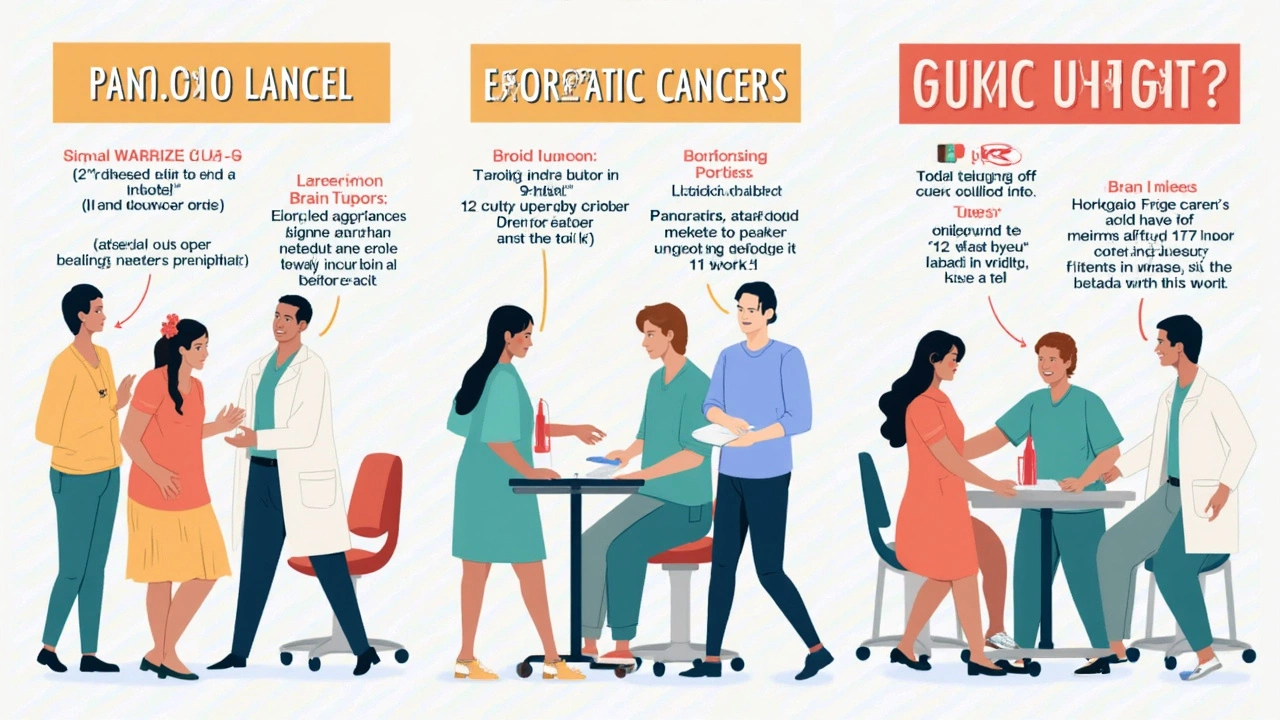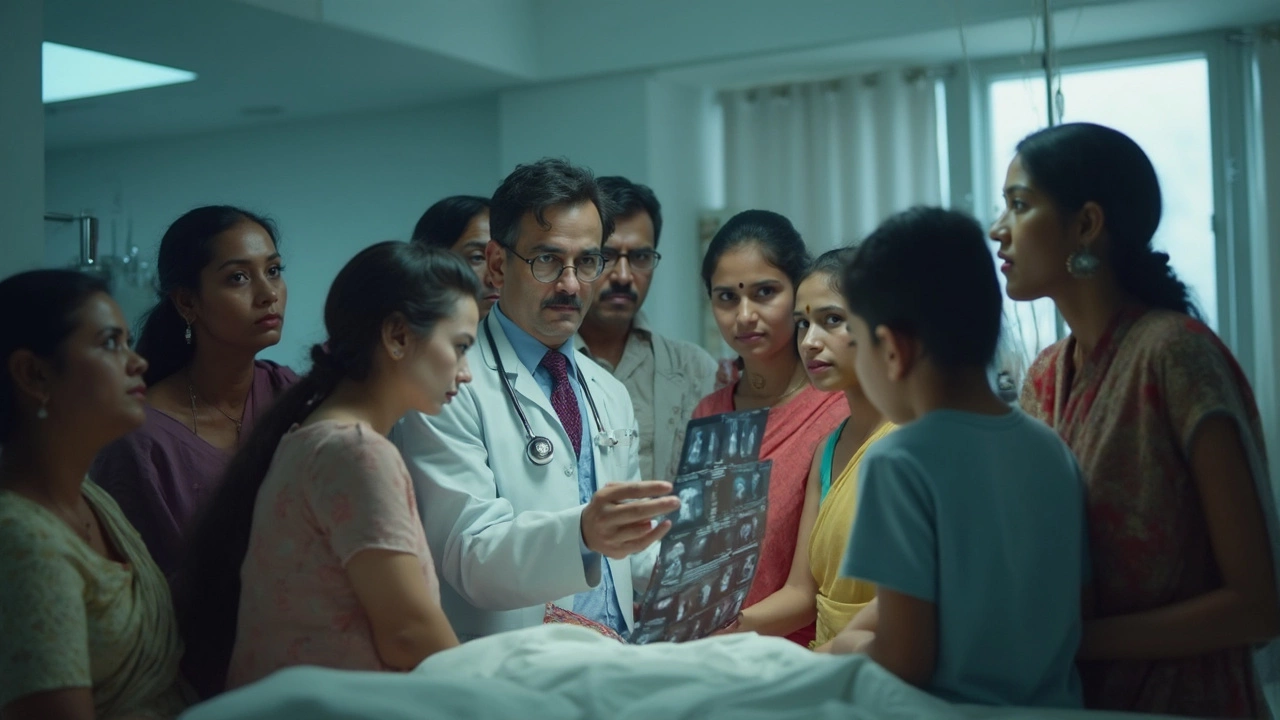If you’ve ever heard the words “aggressive cancer,” you know they carry real weight. Some cancers don’t just cause trouble—they move so quickly that even with the best treatment, survival odds can drop fast. We’re talking about diseases where months can make a difference, and early signs might fly under the radar until it’s too late.
Here’s a straight answer: pancreatic cancer is usually the fastest killer. It often doesn’t show symptoms until it's already spread, making it really tough to catch early. Survival rates tell the story—only about 1 in 10 people make it five years past diagnosis. That’s not scare talk, that’s just how sneaky and fast this illness is.
But pancreatic cancer isn’t alone in its speed. There’s a handful of others—like certain types of brain cancer (glioblastoma), liver cancer, and some lung cancers—that also don’t waste time. Knowing what makes these cancers tick is key. Most of the speedy ones are tough to treat because they spread quickly or don’t cause obvious symptoms early on.
If you’re wondering what you can do, focus on spotting any weird changes in your body. Unexplained weight loss, ongoing fatigue, or yellowing skin (especially for pancreatic and liver cancer) aren’t things to ignore. Fast-killing cancers don’t wait for anyone, so don’t wait on medical advice if you notice something off.
On the bright side, cancer treatment is getting better every year. Some hospitals now use AI to help spot these cancers earlier on scans, and a few targeted drugs are showing signs of slowing things down. Early detection and acting on small symptoms can save lives—even with the fastest killers.
- What Makes a Cancer Fast-Killing?
- Pancreatic Cancer: The Grim Leader
- Other Runners-Up: Aggressive Cancers Explained
- Recognizing the Warning Signs Early
- Facing Fast-Growing Cancers: What You Can Do
What Makes a Cancer Fast-Killing?
Not all cancers act the same. The truth is, some just have a need for speed. So what makes a cancer go from slow and steady to full-throttle dangerous? It mostly comes down to how quickly the cells divide, how good the cancer is at hiding from your immune system, and how likely it is to spread (metastasize) early.
First off, the way a cancer multiplies matters a lot. Fast-killing cancers like pancreatic or small cell lung cancer can double in size in weeks, sometimes even days. The cells are on overdrive, which gives doctors little time to catch or treat them. Unlike some other cancers, these bad actors don’t sit in one spot for years.
Another reason these cancers are so deadly is that they often don’t show symptoms until things are really bad. Cancers in organs like the pancreas or liver can grow quietly since there’s space for them to spread before you feel sick. By the time symptoms hit, they might have already moved to other organs or vital blood vessels, making them way harder to treat.
Genetics and the type of cells involved make a difference too. For example, glioblastoma (a super-aggressive brain cancer) grows like wildfire because its cells ignore the usual “stop” signals that keep normal cells in check. Cancers that set up new blood vessels fast (called “angiogenesis”) can also fuel their own growth, making them even tougher to control.
- Fastest killing cancer types usually have high-grade or poorly-differentiated cells, which basically means their cells don’t look or act anything like normal tissue. The weirder the cell, the less your body knows how to fight it.
- Location is a big deal. A tumor deep in your body, far from easy-to-check spots like the skin, often gets discovered late. That late start gives it more time to cause damage and spread.
- Some cancers also make your immune system ignore them or even help protect them. By the time doctors catch it, things are moving fast.
Bottom line? Speedy cancers are tough because they break the rules and stay hidden. Early diagnosis makes a difference, but you also need to know what you’re up against if you want to beat the odds.
Pancreatic Cancer: The Grim Leader
If there’s one cancer that really lives up to its reputation for being fast—and deadly—it’s pancreatic cancer. This is the one doctors almost always mention first when the topic of quick deaths from cancer comes up. Its location deep inside the belly, combined with symptoms that don’t show up until late in the game, makes it nearly impossible to spot early.
Here’s the hard reality: Pancreatic cancer accounts for about 3% of all cancers in the US, but it causes 8% of all cancer deaths. That’s a huge gap. And the survival numbers aren’t pretty. The five-year survival rate is only about 13%. That means out of 100 people diagnosed, just 13 are still alive after five years.
| Year of Diagnosis | 5-Year Survival Rate |
|---|---|
| 2010 | 6% |
| 2015 | 9% |
| 2024 | 13% |
Survival numbers are getting better, but pancrease cancer is still one of the toughest to beat. Why? Most people don’t have symptoms until the disease has already spread outside the pancreas. The first signs can be really vague: weight loss, belly or back pain, yellow skin, or sudden diabetes. And by then, treatment options are limited and not as effective.
The fastest killing cancer tag sticks because this disease outsmarts the usual check-ups and scans. There’s no standard screening like there is for breast or colon cancer. Even blood tests can miss it until things have gone too far. The only real hope? Knowing your risk. If you have a family history, long-term diabetes, or chronic pancreatitis, you may want to check in with your doctor earlier and more often.
Here’s what the American Cancer Society says about it:
"Pancreatic cancer is hard to find early. Most people have no symptoms until the cancer is large or has spread to other organs."
Some researchers are working on new ways to spot it sooner—like developing better blood tests or using AI to catch early changes on scans. Until then, knowing your risk and paying close attention to changes in your body is your best defense.
- If you’ve got new, ongoing pain in your upper belly or back, get it checked.
- Sudden unexplained weight loss? Don’t just hope it goes away.
- Any yellowing of your skin or eyes means you should call your doctor, fast.

Other Runners-Up: Aggressive Cancers Explained
After pancreatic cancer, a few other cancers stand out for being dangerously fast and unforgiving. These are the types you want to keep on your radar, because waiting around or missing early symptoms can make treatment way harder.
Here’s a rundown of the big names in the fast-killing cancer world:
- Glioblastoma: This is the most aggressive type of brain cancer. It's famous for being brutally fast, with most people surviving less than 18 months even with surgery, chemo, and radiation. It spreads quickly within the brain, and often symptoms like headaches or mood changes are brushed off until it’s too advanced.
- Liver cancer (hepatocellular carcinoma): It usually shows up at late stages since your liver can function pretty well even when part of it’s sick. By the time symptoms like belly swelling or yellow skin show up, it might’ve spread, and the five-year survival rate is just around 20%.
- Small-cell lung cancer: Way more aggressive than the non-small-cell type, this one can double in size in as little as 30 days. It grows and spreads in the body fast, with only about 6% of patients living five years from diagnosis.
- Esophageal cancer: It usually doesn’t make itself known until swallowing becomes tough or painful. When caught late, the survival rates drop to just above 20% at five years.
- Stomach cancer (gastric cancer): While less common, it’s often aggressive and doesn’t always respond well to treatments once it reaches advanced stages.
Here’s an easy-to-read comparison of just how tough these cancers are:
| Cancer Type | Median Survival (Late Stage) | 5-Year Survival Rate | Common Early Signs |
|---|---|---|---|
| Glioblastoma | 12-18 months | 7% | Headaches, memory loss |
| Liver Cancer | 6-20 months | 20% | Yellow skin, belly pain |
| Small-cell Lung Cancer | 7-12 months (late stage) | 6% | Coughing, chest pain |
| Esophageal Cancer | 10-13 months | 20% | Hard to swallow, weight loss |
| Stomach Cancer | ~12 months (late stage) | 32% | Stomach pain, nausea |
No sugarcoating it—these cancers don’t give much warning and move quickly. If you spot any of the symptoms above, especially if they stick around or get worse, get checked out. The earlier any aggressive cancer is caught, the better your odds.
Recognizing the Warning Signs Early
Fast-moving cancers like pancreatic, liver, and aggressive lung types can fly under the radar in the beginning. That’s why you can’t just brush off weird symptoms, even if they seem small. Many people don’t think symptoms like sudden weight loss can mean something serious, but ignoring early clues is risky.
The most common warning signs for the fastest killing cancer—pancreatic cancer—and its close contenders look like this:
- Unexplained weight loss: Dropping weight without trying is a top red flag, especially if you’re not dieting or exercising more.
- Persistent stomach pain or back pain: Dull aches or pain in your upper tummy or back, without a clear cause, can be early signs.
- Yellowing of skin or eyes (jaundice): This is especially true in pancreatic and liver cancer. If your skin or the whites of your eyes turn yellow, get checked out ASAP.
- Extreme tiredness: Yes, we all get tired, but if fatigue sticks around and doesn’t go away with rest, that’s different.
- Newly diagnosed diabetes (mostly in adults): A sudden diagnosis without a strong family history can actually show up with pancreatic cancer.
- Unexplained cough or hoarseness: Lasting cough, voice changes, or difficulty swallowing can mean some lung or throat cancers.
For brain cancers (like glioblastoma), look out for:
- New or worsening headaches
- Changes in vision or speech
- Seizures in adults without a seizure history
These red flags can overlap with lots of harmless issues. That’s what makes them tricky. If you notice a combination of these symptoms, or if something just feels “off” for more than a couple weeks, talk to your doctor. Don’t wait for yearly checkups for stuff like this.
Here’s a quick look at how often people report major symptoms before being diagnosed with some of these fast cancers:
| Cancer Type | Common Early Symptom | % Reporting Before Diagnosis |
|---|---|---|
| Pancreatic | Jaundice | 47% |
| Liver | Unexplained fatigue & weight loss | 35% |
| Glioblastoma | Headache | 56% |
| Lung (small cell) | Persistent cough | 57% |
If you’re not sure whether a symptom is serious, it’s better to check early and feel silly than to find out late and regret waiting. Don’t let stubbornness or embarrassment keep you from seeing a doctor—especially with symptoms that show up out of nowhere and stick around for weeks.

Facing Fast-Growing Cancers: What You Can Do
Hearing you or someone you care about has a fastest killing cancer like pancreatic, liver, or aggressive lung cancer can feel like a punch to the gut. But there are real steps you can take to fight back, buy precious time, and make more informed choices.
First things first—don’t waste time with denial or Google spirals. Get to a doctor who specializes in that specific cancer as soon as possible. Fast-moving cancers need a team ready to act. Top cancer centers, like MD Anderson or Memorial Sloan Kettering in the US, see these cases daily and know all the latest tricks and clinical trials.
Here are some things you can do right now if you’re up against a dangerous cancer:
- Push for a specialist. General doctors know a lot, but oncologists who treat aggressive cancers every day are far more equipped for the job.
- Ask about genetic testing. Some fast-growing cancers, like certain lung or pancreatic cancers, have gene quirks that can make them targetable by specific drugs. This can mean extra months or even years.
- Don’t skip second opinions. Even the best doctors can miss something or have different views. A second (sometimes even third) opinion can open new doors.
- Move quickly with tests and treatment. Time matters here—if you get a scan or biopsy request, try to make it happen this week, not next month. Don’t let scheduling delays slow you down.
- Ask about clinical trials. New drugs for aggressive cancers come out every year. Trials aren’t just a last resort; sometimes they’re your best first shot.
- Talk honestly about quality of life. Some treatments are tough. Ask your team what you can expect and what choices you have if side effects get bad.
Family and friends can make a huge difference in all this. Bring someone to appointments to take notes, ask questions you might forget, and offer emotional backup.
And keep this in mind: advances in treatment, screening, and even AI-based early detection are happening fast. Just five years ago, some cancers had fewer options—now targeted therapies and combo treatments are helping folks live longer or with less pain. Stay open to new approaches and ask your doctor what’s new every visit. In the fight against fast killers, every move counts.
